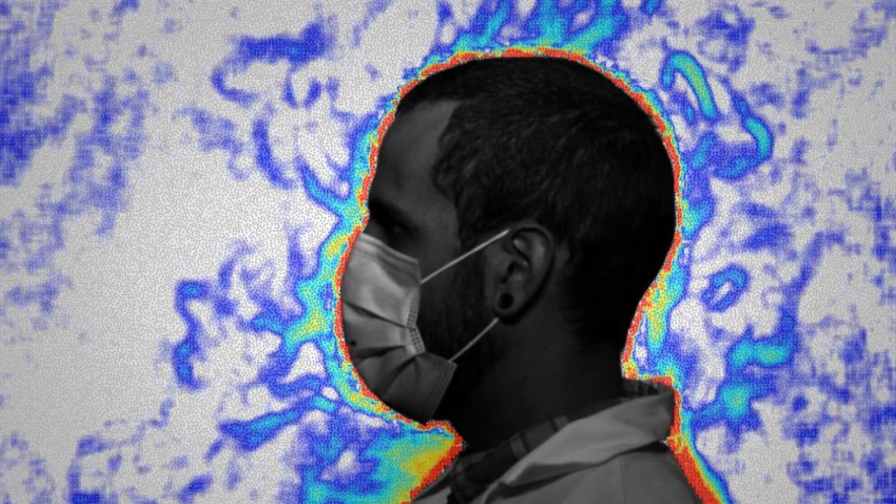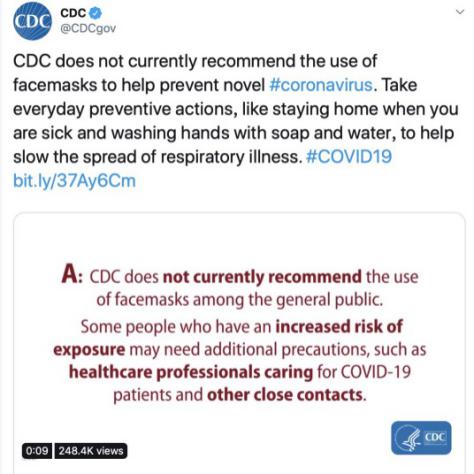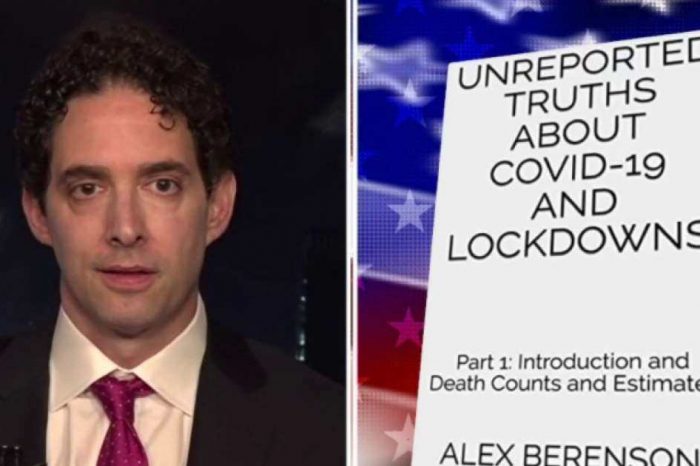Effectiveness of masks: What is the science behind mask-wearing?

Today, former U.S. Vice President Joe Biden calls for a 3-month mandatory nationwide mask wearing as part of his plan to combat coronavirus. The rationale behind the recommendation for wearing masks or other face coverings is to reduce the risk of cross-infection via the transmission of respiratory droplets from infected to healthy individuals. But, the question most Americans are asking is: What scientific evidence do we have that wearing a mask is effective in preventing COVID-19?
When it comes to masks, there is no “settled science.” However, several studies published in the last two months show that wearing face masks or coverings can reduce the spread of the deadly coronavirus. These studies lend support for health policies requiring people to wear masks or coverings in public. Some scientists are still skeptical and argue that the results of the studies should be viewed with caution.
A research from Florida Atlantic University’s College of Engineering and Computer Science, published in the journal Physics of Fluids, found that loosely folded facemasks and bandana-style coverings provide minimal stopping-capability for the smallest aerosolized respiratory droplets.
The study further demonstrates through visualization of emulated coughs and sneezes, a method to assess the effectiveness of facemasks in obstructing droplets. Several simulations also illustrate that cloth masks have the potential to limit the spread of droplets from sneezing and coughing and eliminate the reach of more dangerous larger droplets.
However, it is clear that wearing masks combined with practicing social distancing plus proper sanitary hygiene, such as washing of hands and not touching the face, reduce the risk of getting coronavirus. Below is a visual animation from MIT of how wearing masks plus social distancing reduce the transmission of COVID-19

At the beginning of the coronavirus pandemic, the World Health Organisation (WHO) and Centers for Disease Control and Prevention (CDC) advised against mask wearing. It was just last month that WHO changed its recommendations encouraging the use of masks where physical distancing is difficult, such as on public transport.
However, WHO was concerned that face coverings give a false sense of protection which may lead people to abandon other crucial strategies, such as hand-washing and social distancing. CDC shared similar message in a video posted on Twitter saying people should not wear masks. Instead, CDC rightly suggested people take proper preventive actions like staying home and practicing proper hygiene.
CDC does not currently recommend the use of facemasks to help prevent novel #coronavirus. Take everyday preventive actions, like staying home when you are sick and washing hands with soap and water, to help slow the spread of respiratory illness. #COVID19 https://t.co/uArGZTJhXj pic.twitter.com/yzWTSgt2IV
— CDC (@CDCgov) February 27, 2020
Below is a screenshot of CDC twitter post.

(Screenshot from CDC’s Twitter page)
What does science really say about the effectiveness of masks?
According to a study conducted by engineers at the University of Edinburgh in Scotland, wearing face masks can help prevent the spread of COVID-19, but they aren’t 100 percent effective. As part of the study, researchers assessed the effectiveness of seven types of face coverings — including medical-grade and homemade masks — when people breathed or coughed while standing or lying down. They were also tested using a dummy attached to a cough-simulating machine.
Here is what study leader, Ignazio Maria Viola, from the university’s School of Engineering, said in a university news release:
“I have generally been impressed by the effectiveness of all the face coverings we tested. However, we discovered that some face coverings allow the emergence of downward or backward jets that people are not aware of and that could be a major hazard to others around them.”
Below is a video of the summary of their finding, courtesy of the Telegraph.
Also in May, the University of Hong Kong published an analysis of 10 randomized controlled trials (RCTs) looking at whether face masks prevented influenza transmission in the community. In conclusion, they found no significant reduction. Hong Kong’s former health minister Yeoh Eng-kiong has said that wearing face masks has limited effectiveness. Yeoh, a professor at the Chinese University of Hong Kong, said masks should be worn in crowded areas, or when people have a cold or cough. He said he does not otherwise wear face masks now, and only does so to be “polite.”
Also in May, the New England Journal of Medicine (NEJM) said, “wearing a mask outside health care facilities offers little, if any, protection from coronanvirus infection.” NEJM has since published an updated guidance, which you can find here.
In related meta-analysis study conducted by the University of East Anglia (UEA), researchers that found wearing a face mask slightly reduces the odds of infection by the wearer, but only by roughly six per cent. Paul Hunter, professor of medicine at University of East Anglia and one of the authors of the study said: “The value of face masks in the community is still an issue that the scientific community has not yet reached consensus on.
Below is Prof Hunter’s response to reported comments from British Prime Minister Boris Johnson about looking at ways of making sure people wear face coverings in shops.
“The Prime Minister is right if he is reviewing England’s position on facemasks. It must be said that the value of facemasks in the community is still an issue that the scientific community has not yet reached consensus on. In part this lack of consensus is due to the different emphasis given to different types of study. Randomised controlled trials (the gold standard of scientific evidence) of facemask use in the community have not proven that mandating their widespread use is protective. Other types of study have given mixed results, some finding no benefit and others like case control studies generally finding them to be protective. Two recent studies, one our own and one by Brauner and colleagues from Oxford University found that face covering mandates have had little impact on the spread of COVID-19 in those countries that implemented them, though as we both accept the data quality for this is poor so no firm conclusions on this issue can be drawn. Unfortunately, it is unlikely that this debate will be resolved anytime soon.
“In our own review, published in March, we concluded that although the evidence was not sufficiently strong to support widespread use of facemasks as a protective measure against COVID-19, we did think that there was enough evidence to support the use of facemasks for short periods of time by particularly vulnerable individuals when in transient higher risk situations. The PM is right to say he does not want a world where everyone has to wear face coverings the whole time everywhere. This would have little if any value and this could also pose additional risks.
“The current requirement to wear face coverings on public transport is one such example of a transient higher risk situation. Their use in shops may also be another example if it is not possible to maintain social distancing. However, if it is mandated to wear them in shops this raises the issue of whether they should be mandated in other contexts. One such context would be pubs and bars where the risk of transmission is arguably much greater than in shops. Face coverings could not be safely used in any establishment that people go to eat and drink. The constant need to be always moving your face covering to take a sip of beer could be a risk.
“Whatever is eventually decided it is vitally important that any policy change is supported by a strong public health education campaign. People will need to know what designs and materials of mask are appropriate, how to wear them properly, how long they should wear them for, and how they should either safely dispose of them or wash them ready for reuse. Materials need to be sufficient to block dispersion of virus and not get too damp in use, they need to cover both the mouth and nose and fit snugly to the face. People should not wear the same mask all day, 5 hours is probably the longest. Worn masks must be disposed of safely to avoid infecting someone else who picks it up and they should be washed before using again. All too often you see people wearing a mask in a way that is not going to achieve much. People do not need to wear masks while walking or exercising outside and wearing masks when taking exercise could be counterproductive. The balance of evidence is that the N95 respirator masks do not provide any additional benefit for people in the community and many cause problems if warn for any period of time. In particular people should not wear N95 respirator masks when exercising.
“The most important thing, however, is that anyone wearing a mask must not assume that they are automatically protected. People should still practice distancing and continue to wash their hands.”
When asked about “How strong is the evidence on the effectiveness of face coverings in reducing transmission of SARS-CoV-2?” Below is the response from Dr Antonio Lazzarino, Department of Epidemiology and Public Health, UCL
“The evidence has not changed in the last few weeks; it’s still extremely weak. The question is why politicians may be changing their minds now. My worry is that masks are a pretense to ease the lockdown to help the economy. But this may well happen at the expense of people’s health. Lockdown is the only measure that is proven to work
In closing, below is a video of Fox News host Laura Ingraham discussing findings from various scientific publications and the need to move beyond the hyperbole and focus on what the latest science tells us.

